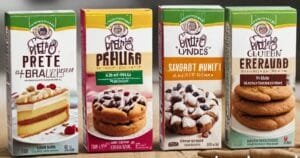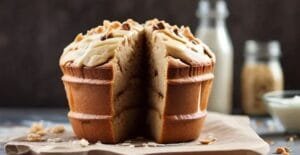6 Easy Steps To More Gluten-free Baking Mixes Sales
-
Introduction
Definition of Gluten-Free Baking Mixes
Gluten-free baking mixes are specially formulated products that allow individuals to bake various goods without using gluten, a protein found in wheat, barley, and rye. These mixes are designed to replicate the texture and taste of traditional baked goods while being safe for those with gluten sensitivities or celiac disease.

Importance of Gluten-Free Diets
A gluten-free diet is crucial for individuals with celiac disease, gluten intolerance, or wheat allergies. For these individuals, consuming gluten can lead to severe health issues, ranging from digestive discomfort to long-term damage to the small intestine. As awareness of gluten-related disorders has grown, so has the demand for gluten-free products, including baking mixes that offer convenience and versatility.
Overview of Article Content
This article will explore everything you need about gluten-free baking mixes, from their ingredients to the best brands available. We’ll also delve into practical tips for baking with these mixes, share delicious recipes, and look at the future trends in gluten-free baking.
-
Understanding Gluten-Free
What is Gluten?
Gluten is a group of proteins found in wheat, barley, and rye that gives dough its elasticity and helps it rise. While gluten is harmless to most people, it can cause severe health problems for those with gluten-related disorders.
Health Implications of Gluten
For people with celiac disease, consuming gluten triggers an immune response that damages the small intestine, leading to nutrient malabsorption and a host of other health issues. Gluten sensitivity and wheat allergies can cause bloating, fatigue, and headaches.
Who Needs a Gluten-Free Diet?
A gluten-free diet is essential for individuals with celiac disease, non-celiac gluten sensitivity, or wheat allergies. It may also benefit those with other autoimmune conditions or digestive disorders, though it’s always best to consult a healthcare provider.
-
Types of Gluten-Free Baking Mixes
All-Purpose Gluten-Free Baking Mixes
All-purpose gluten-free baking mixes are versatile products that can be used for a wide range of baked goods, from bread to cookies. They typically contain a blend of gluten-free flour like rice flour, almond flour, and tapioca starch.
Specialty Gluten-Free Mixes
Speciality gluten-free mixes are designed for specific types of baking, such as bread, pizza dough, or pancakes. These mixes often contain additional ingredients tailored to achieve the best results for that particular baked good.
Homemade vs. Store-Bought
While store-bought gluten-free baking mixes offer convenience, some bakers prefer to create them at home. Homemade mixes allow greater control over ingredients and can be customized to suit individual tastes and dietary needs.
-
Ingredients in Gluten-Free Baking Mixes
Common Ingredients in Gluten-Free Mixes
Gluten-free baking mixes often contain a blend of alternative flours such as rice flour, almond flour, and tapioca starch. Other common ingredients include xanthan gum or guar gum to mimic the elasticity of gluten and leavening agents like baking powder.
Nutritional Considerations
Gluten-free products can sometimes be lower in fibre and nutrients than their gluten-containing counterparts. It’s important to look for mixes fortified with essential vitamins and minerals or to supplement your diet with other nutrient-rich foods.
Additives and Preservatives
Some gluten-free baking mixes contain additives or preservatives to extend shelf life or improve texture. While these ingredients are generally safe, those seeking a more natural option may prefer mixes with minimal additives.
-
How to Use Gluten-Free Baking Mixes
Tips for Success
When baking with gluten-free mixes, following the instructions carefully is important. Mixing thoroughly, using the right amount of liquid, and allowing the batter or dough to rest can help achieve the best results.
Common Challenges and How to Overcome Them
Baking gluten-free can be challenging due to the lack of gluten, which affects the texture and rise of baked goods. Common issues include dense or crumbly textures. To overcome these challenges, consider adding an extra egg, mixing flours, or experimenting with different brands until you find one that works.
Baking with Gluten-Free Flour vs. Baking Mixes
While gluten-free flours offer flexibility, baking mixes are pre-blended to achieve specific results, making them a convenient choice for quick and reliable baking. However, using individual flours allows for more customization and control over the final product.
-
Best Gluten-Free Baking Mix Brands
Popular Store Brands
Several brands have become well-known for gluten-free baking mixes, including Bob’s Red Mill, King Arthur Flour, and Pamela’s Products. These brands offer various mixes that cater to different baking needs.
Best Brands for Specific Needs
For those with additional dietary restrictions, brands like Simple Mills and Namaste Foods offer gluten-free mixes free from other common allergens like dairy, soy, and nuts.
Comparing Prices and Availability
Gluten-free baking mixes can vary widely, with some premium brands costing significantly more than others. Availability may also be an issue in some areas, so it’s worth checking online retailers if you need help finding a particular brand.
-
Recipes Using Gluten-Free Baking Mixes
Gluten-Free Bread Recipes
Baking gluten-free bread can be tricky, but you can create delicious loaves that rival traditional bread with the right mix. Popular recipes include basic sandwich bread, artisan-style loaves, and quick breads like banana or zucchini.
Gluten-Free Dessert Recipes
Gluten-free baking mixes make it easy to whip up sweet treats like cakes, cookies, and brownies. Some favourite recipes include chocolate chip cookies, vanilla cupcakes, and fudgy brownies.
Quick and Easy Recipes
For those short on time, gluten-free baking mixes can create quick and easy recipes like pancakes, muffins, and pizza crusts. These recipes are perfect for busy mornings or weeknight dinners.
-
Gluten-Free Baking Tips and Tricks
Avoiding Contamination
Cross-contamination is a major concern for those on a gluten-free diet. To avoid this, ensure all baking tools and surfaces are thoroughly cleaned before use, and store gluten-free ingredients separately from those containing gluten.
Improving Texture and Flavor
Gluten-free baked goods can sometimes lack the texture and flavour of their gluten-containing counterparts. Add ingredients like yoghurt, applesauce, or extra eggs to your recipes to improve this. Experimenting with different types of gluten-free flour can also help.
Storing Gluten-Free Baking Mixes
Gluten-free baking mixes should be stored in a cool, dry place away from direct sunlight. Once opened, keeping them in an airtight container is best to prevent moisture and contamination.
-
Expert Insights and Case Studies
Interview with a Gluten-Free Baker
We spoke with a professional gluten-free baker to get their tips and insights on achieving the best results with gluten-free baking mixes. They emphasized the importance of understanding the unique properties of gluten-free ingredients and experimenting to find what works best for you.
Success Stories from Gluten-Free Baking Enthusiasts
Many home bakers have succeeded with gluten-free baking mixes, creating everything from wedding cakes to artisan bread. These stories highlight the versatility and potential of gluten-free baking.

-
Future Trends in Gluten-Free Baking
Emerging Ingredients in Gluten-Free Baking
As the demand for gluten-free products grows, new ingredients like sorghum flour, teff, and cassava flour are becoming more popular in gluten-free baking mixes. These ingredients offer unique flavours and nutritional benefits.
Innovations in Gluten-Free Baking Mixes
Innovation in the gluten-free market is ongoing, with companies developing new products that better mimic the texture and taste of traditional baked goods. From improved leavening agents to enhanced nutritional profiles, the future of gluten-free baking looks promising.
The Future of Gluten-Free Diets
With growing awareness of gluten-related disorders and an increasing number of people choosing to go gluten-free, the market for gluten-free products is expected to continue expanding. This trend will likely lead to more variety and better products for consumers.
-
Conclusion
Recap of Key Points
Gluten-free baking mixes are convenient and versatile for those following a gluten-free diet. You can create delicious and satisfying gluten-free baked goods by understanding the ingredients, selecting the right brands, and following best practices.
Final Thoughts and Recommendations
Whether you’re new to gluten-free baking or a seasoned pro, experimenting with different mixes and recipes can open up a world of possibilities. Feel free to try new things and find what works best for your needs.
-
FAQ
What is the Best Gluten-Free Baking Mix?
The best gluten-free baking mix depends on your specific needs and preferences. Brands like Bob’s Red Mill and King Arthur Flour are popular choices, but it’s worth trying different options to find the one that works best for you.
Can Gluten-Free Baking Mixes be Used for All Recipes?
While gluten-free baking mixes are versatile, they may only work perfectly for some recipes. It’s important to follow the instructions on the package and make adjustments as needed.
How to Store Gluten-Free Baking Mixes?
Store gluten-free baking mixes in a cool, dry place, and keep them in an airtight container once opened to maintain freshness and prevent contamination.

